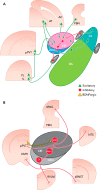The Physiology of Fear: Reconceptualizing the Role of the Central Amygdala in Fear Learning
- PMID: 26328883
- PMCID: PMC4556826
- DOI: 10.1152/physiol.00058.2014
The Physiology of Fear: Reconceptualizing the Role of the Central Amygdala in Fear Learning
Abstract
The historically understood role of the central amygdala (CeA) in fear learning is to serve as a passive output station for processing and plasticity that occurs elsewhere in the brain. However, recent research has suggested that the CeA may play a more dynamic role in fear learning. In particular, there is growing evidence that the CeA is a site of plasticity and memory formation, and that its activity is subject to tight regulation. The following review examines the evidence for these three main roles of the CeA as they relate to fear learning. The classical role of the CeA as a routing station to fear effector brain structures like the periaqueductal gray, the lateral hypothalamus, and paraventricular nucleus of the hypothalamus will be briefly reviewed, but specific emphasis is placed on recent literature suggesting that the CeA 1) has an important role in the plasticity underlying fear learning, 2) is involved in regulation of other amygdala subnuclei, and 3) is itself regulated by intra- and extra-amygdalar input. Finally, we discuss the parallels of human and mouse CeA involvement in fear disorders and fear conditioning, respectively.
©2015 Int. Union Physiol. Sci./Am. Physiol. Soc.
Conflict of interest statement
No conflicts of interest, financial or otherwise, are declared by the author(s).
Figures


Similar articles
-
Calcitonin gene-related peptide erases the fear memory and facilitates long-term potentiation in the central nucleus of the amygdala in rats.J Neurochem. 2015 Nov;135(4):787-98. doi: 10.1111/jnc.13246. Epub 2015 Aug 18. J Neurochem. 2015. PMID: 26179152
-
Elevated Arc/Arg 3.1 protein expression in the basolateral amygdala following auditory trace-cued fear conditioning.Neurobiol Learn Mem. 2013 Nov;106:127-33. doi: 10.1016/j.nlm.2013.07.010. Epub 2013 Jul 24. Neurobiol Learn Mem. 2013. PMID: 23891993
-
The indirect amygdala-dorsal striatum pathway mediates conditioned freezing: insights on emotional memory networks.Neuroscience. 2008 Apr 22;153(1):84-94. doi: 10.1016/j.neuroscience.2008.02.013. Epub 2008 Feb 19. Neuroscience. 2008. PMID: 18367339
-
Long-term potentiation as a substrate for memory: evidence from studies of amygdaloid plasticity and Pavlovian fear conditioning.Hippocampus. 2002;12(5):592-9. doi: 10.1002/hipo.10099. Hippocampus. 2002. PMID: 12440575 Review.
-
Neuropeptide signalling in the central nucleus of the amygdala.Cell Tissue Res. 2019 Jan;375(1):93-101. doi: 10.1007/s00441-018-2862-6. Epub 2018 Jun 8. Cell Tissue Res. 2019. PMID: 29948174 Review.
Cited by
-
Dorsal Medial Habenula Regulation of Mood-Related Behaviors and Primary Reinforcement by Tachykinin-Expressing Habenula Neurons.eNeuro. 2016 Jul 18;3(3):ENEURO.0109-16.2016. doi: 10.1523/ENEURO.0109-16.2016. eCollection 2016 May-Jun. eNeuro. 2016. PMID: 27482535 Free PMC article.
-
Neural mediators of subjective and autonomic responding during threat learning and regulation.Neuroimage. 2021 Dec 15;245:118643. doi: 10.1016/j.neuroimage.2021.118643. Epub 2021 Oct 24. Neuroimage. 2021. PMID: 34699966 Free PMC article.
-
Memory consolidation within the central amygdala is not necessary for modulation of cerebellar learning.Learn Mem. 2017 May 15;24(6):225-230. doi: 10.1101/lm.045310.117. Print 2017 Jun. Learn Mem. 2017. PMID: 28507031 Free PMC article.
-
Kv1.1 channels mediate network excitability and feed-forward inhibition in local amygdala circuits.Sci Rep. 2021 Jul 26;11(1):15180. doi: 10.1038/s41598-021-94633-3. Sci Rep. 2021. PMID: 34312446 Free PMC article.
-
Chronic adolescent stress attenuates morphine-induced antinociception and central amygdala neuronal activation in adult Wistar rats.Physiol Behav. 2025 Oct 1;299:114996. doi: 10.1016/j.physbeh.2025.114996. Epub 2025 Jun 13. Physiol Behav. 2025. PMID: 40517924
References
-
- al Maskati HA, Zbrozyna AW. Stimulation in prefrontal cortex area inhibits cardiovascular and motor components of the defence reaction in rats. J Auton Nerv Syst 28: 117–125, 1989. - PubMed
Publication types
MeSH terms
Substances
Grants and funding
- R01 MH071537/MH/NIMH NIH HHS/United States
- T32 GM008169/GM/NIGMS NIH HHS/United States
- P51 OD011132/OD/NIH HHS/United States
- R00 HL-107675-03/HL/NHLBI NIH HHS/United States
- R01 MH096764/MH/NIMH NIH HHS/United States
- P51 RR000165/RR/NCRR NIH HHS/United States
- R21 MH102191/MH/NIMH NIH HHS/United States
- R21 MH-102191/MH/NIMH NIH HHS/United States
- R01 MH-071537/MH/NIMH NIH HHS/United States
- R01 MH-096764/MH/NIMH NIH HHS/United States
- P51OD011132/OD/NIH HHS/United States
- P51RR000165/RR/NCRR NIH HHS/United States
- R00 HL107675/HL/NHLBI NIH HHS/United States
LinkOut - more resources
Full Text Sources
Other Literature Sources

